About The Pantheon In Rome, Italy…
About the Pantheon in Rome, Italy…
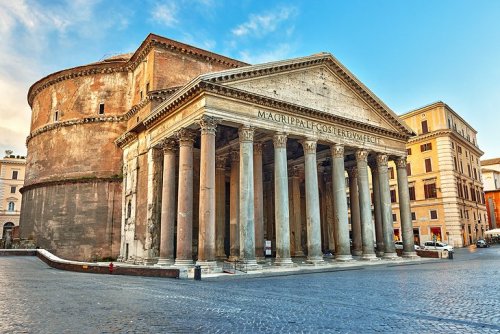
The Pantheon in Rome
The Pantheon in Rome, now a church, was built as a temple to all the gods. It has been a shrine for architects since the Renaissance. It is also a worthy tribute to the skills of the ancient Roman masons and engineers who built it and the incredible alchemy of their concrete mix.
If there Was a competition to find the most durable and beautiful concrete structure ever built, the Pantheon in Rome would most surely win the prize. It also stands as a monument to the genius of Roman concrete.
Commissioned by Hadrian (who was emperor 117-138 CE) as a temple to all the gods, the Pantheon replaced Agrippa’s earlier temple following a fire. It is still the most visited site in Italy, having weathered centuries of tourists, floods, wars and earthquakes.
Its huge concrete dome – 43.4m in diameter and 21.75m high – was unrivalled in size until the building of Florence Cathedral in the 1400s, and is still the largest ever made with unsupported concrete.
“The mastery of building something so daring and having the structure resist essentially without any structural support for more than 19 centuries is simply extraordinary,” says Renato Perucchio, professor of mechanical engineering and director of the Archaeology, Technology, and Historical Structures Programme at the University of Rochester in the US.
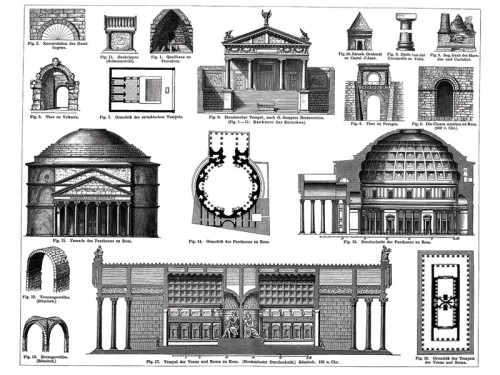
So how did the Romans do it, what were the secrets of their concrete recipe and what lessons can architects and civil engineers learn from its construction today?
As every builder knows, foundations are everything. One of the most overlooked aspects of the Patheon’s remarkable construction lies below its famous dome. Although Rome is not on one of Italy’s major seismic zones, it has known earthquakes. Many historians believe seismic activity caused damage to the Colosseum. Moreover, until some of the River Tiber’s tributaries were buried in the late 19th century, it was also subject to major flooding.
The foundations of the Pantheon were made of concrete, originally 4.7m deep and 7.3m thick. During construction, however, they cracked due to the marshy, clay land below. “For this reason, a second reinforcement ring was built, projecting three metres beyond the original perimeter,” according to the Archeoroma website. Thick buttress walls were also built to the south of the building anchored to the Basilica of Neptune next door. “This had the effect of stabilising the structure by counterbalancing the forces and weights at either end of it,” Archeoroma writes.
Romans did not invent concrete. It had already been around for hundreds of years before the Pantheon was built.
Curiously that accolade probably goes to the Nabatean Bedouin tribes of the land that is today southern Syria and northern Jordan, who were using it to create hidden underground water cisterns around 700BC.
The basic concrete recipe the Romans followed can be found in the Roman architect Vitruvius’s book ‘De Architectura’, published 100 years before the building of the Pantheon. He described how to make concrete out of lime and pozzolana sand, a type of volcanic ash found near Naples, all mixed with stone mass.
Different aggregates were used to give the concrete diverse densities. Travertine limestone gave the Pantheon’s foundations a density of 2,200kg per cubic metre, while lighter rock was chosen for the dome.
Pozzolans, made of siliceous and aluminous materials, possess little or no cementitious value, but when mixed with water, react chemically with calcium hydroxide at ordinary temperature to form cementitious compounds.
It was the chemistry of this material that formed the basis of the durability of the dome, enabling it to survive two millennia without the steel tension rods used today.

Indeed, the Romans understood that the bigger the structure, the stronger it was, because the simplest way to keep concrete in compression is to put heavy stuff on top of it, like more concrete.
It is a trick still used today. Many large concrete dams are either gravity or arch structures that rely on their own weight and geometry to withstand water.
However, the circular structure of the dome meant that before the ancient engineers could start making its concrete ceiling, they needed to figure out how to direct the weight away from the centre. If they didn’t, and removed the wooden structure holding it in place, the 3,000 tonnes of concrete used to make the dome would have pushed outwards and the whole edifice would have collapsed under its own weight.
Even the kind of scaffolding framework used to support such a framework is still under discussion. “Think of the design of the scaffolding that holds a structure of that weight,” says Perucchio. “They [the ancient Romans] had a high mastery in using timber framing in a way that no other earlier cultures had developed.”
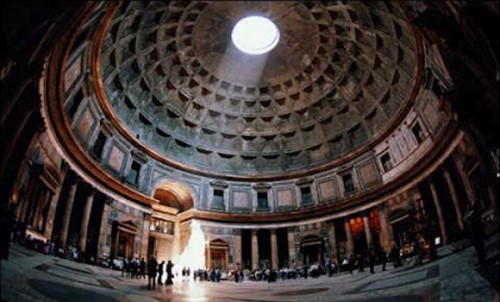
Today when we build in concrete, we introduce a steel tension rod which picks up half of the stresses in the concrete. The Romans used their ancient concrete recipe, and an abundance of highly skilled artisan labour, who tamped the stiff mixture into moulds and walls, rather than pouring it as is done today.
To build the dome, the Roman builders constructed a solid base, a wall six metres thick in the shape of a rotunda, to act as the foundation for the ceiling. They then used the vertical walls on either side to buttress the dome itself.
As the ceiling rose towards its apex, the master craftsmen mixed increasingly lighter aggregate materials into the concrete.
This principle of using different weights of aggregate goes from the heavy travertine used in the base right up to the top of the dome.
“It doesn’t look like it from the inside but on the outside it’s a very thick dome, but relatively light,” says Norbert Delatte, head of the School of Civil and Environmental Engineering at Oklahoma State University.
In some parts, the ancient builders mixed in small clay vases, called amphorae, to control the weight.
The aggregate of the concrete used to make the upper dome region consists of alternating layers of light tuff, found in abundance north of Rome, and pumice stone, the material we use today to file off rough skin. The concrete substance at the top of the dome had a density of just 1,350kg per cubic metre.
To make the ceiling even lighter, masons moulded recessed concrete waffle-like panel bricks called coffers; five layers of these bricks formed the interior ceiling. They pounded the concrete into the moulds using some kind of tamper, most likely made of wood or iron.
This meant that aesthetically, they had allowed an area of the dome to be decorated while simultaneously reducing the amount of concrete necessary for the dome itself.
At the top, the Pantheon’s crowning glory is an open oculus, 7.8m in diameter, which allowed light to shine in, adding to the sense of wonderment the building still incites today. But most importantly, it meant the apex of the dome was made of the lightest material of all, air.

Today, engineers all over the world are looking at the chemical properties of Roman concrete to see if it can be reproduced today to make buildings that last longer. Although the basic ingredients were set out by Vetruvius, modern measuring technologies are making it easier to ascertain the exact chemical properties from just small samples of material.
Yet the clever use of engineering and the unique Roman concrete material is not the only reason this enduring temple to all the gods is still there to inspire awe today. History also played a role in its staying power. The event that probably most ensured its long destiny happened in 609 AD, nearly 400 years after it was built.
The Emperor Phocas, the Byzantine emperor in the east, gave the Pantheon to the Catholic Church in Rome. The Vatican has used it as a place of worship ever since, while its formidable structure also still serves a shrine for architects and engineers the world over.
By Hilary Clarke.
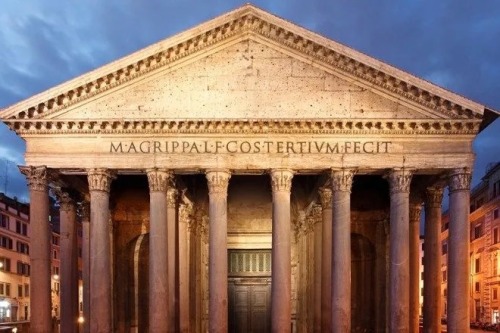
More Posts from Quatrowins and Others












Everyday life in Tokyo
![Fushimi-inari, Kyoto [OC]](https://64.media.tumblr.com/8a514b5bccdf04c475e4eb2c2dc814aa/tumblr_pme2lr3msk1vz9beoo1_500.jpg)
Fushimi-inari, Kyoto [OC]
Nice setting for a little brunch

capaseccayacht via instagram
Let it be washed away…

How lovers call each other around the world
What makes lovers bloom in the most beautiful colors of their deepest inner feelings is a grave insult for 99% of all people around them.
Disclaimer: This is not a comprehensive list. I chose the weirdest/funniest terms.
Afrikaans: klein bokkie (little buck)
Arabic: بصري [basari] (my eyesight)
Catalan: colomí/colometa (pidgeon)
Dutch: dropje (little licorice), mopje (little joke)
English: “pumpkin”, “sweet pea”
Finnish: kulta (gold), muru (breadcrumb)
French: ma puce (my flea), mon chou (my cabbage)
German: Hase (bunny), Maus (mouse)
Indonesian: jantung hatiku (my heart and liver)
Irish: a leanbh (my child), mo chuisle (my pulse)
Italian: biscottino (little biscuit), microbino mio (my little microbe)
Japanese: 卵方の顔 [tamago hō no kao] (egg with eyes)
Korean: 우리강아지 [u-ri gang-a-ji] (my puppy)
Mandarin: 沉鱼落雁 (chényú luòyàn) ([beautiful enough to] make fish sink and birds alight), 心肝 [xīngān] (heart-liver)
Persian: باشد که یک موش شما را بخورد [bashed keh ak mewsh shema ra bekhewred] (May a mouse eat you)
Polish: misiu (little bear), okruszku (breadcrumb), rybko (little fish)
(Brazilian) Portuguese: chuchuzinho (little pumpkin)
Russian: лапочка [lapochka] (paw), рыбка [rybka] (little fish), голубчик/голубушка [golubchik/golubushka] (little pidgeon)
Spanish: cielo (sky), gordo/a (fat boy/girl)
Swedish: söt kanin (cute bunny)
Thai: ช้างน้อย [cĥāngn̂x/chang noi] (elephant)
Tibetan: སྙིང་སྡུག་ལགས། [nyingdu-la] (most honored poison of my heart)
Turkish: patlıcanım (my eggplant)
Life… imitating art.


























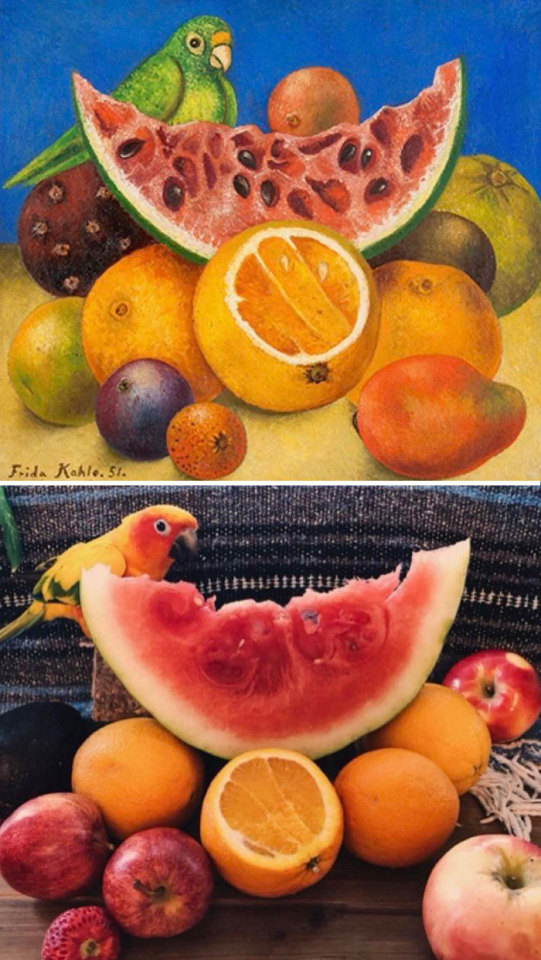



Please please please, I’m begging people, start talking about indonesia occupied papua. Over the last 50 years Indonesia has killed over 500,000 native Papuans in their occupation of the west half of the island.
This is also a genocide that should be talked about. It needs to be addressed, but it’s ignored on the global stage.
Free Papua!

A clip from Anthony Bourdain’s Parts Unknown Singapore episode has resurfaced where he challenges the Singaporean hosts for exploiting domestic labour. The Vice article links to https://besthousekeeper.sg/domestic-helpers-in-singapore/ and the way they describe the different ethnic groups is frankly disgusting. See for example, these are from the website:




This is shameful.

Phinda Rock Lodge South Africa
© andBeyondPhinda
-
 manessha545 liked this · 11 months ago
manessha545 liked this · 11 months ago -
 nothereorthere2025 liked this · 2 years ago
nothereorthere2025 liked this · 2 years ago -
 bedford123 liked this · 2 years ago
bedford123 liked this · 2 years ago -
 artamidae liked this · 2 years ago
artamidae liked this · 2 years ago -
 cedarbogblog liked this · 2 years ago
cedarbogblog liked this · 2 years ago -
 grandstyle reblogged this · 2 years ago
grandstyle reblogged this · 2 years ago -
 grandstyle liked this · 2 years ago
grandstyle liked this · 2 years ago -
 usuallychattering liked this · 2 years ago
usuallychattering liked this · 2 years ago -
 anenglishmanabroad reblogged this · 2 years ago
anenglishmanabroad reblogged this · 2 years ago -
 anenglishmanabroad liked this · 2 years ago
anenglishmanabroad liked this · 2 years ago -
 ahabsrevenge liked this · 2 years ago
ahabsrevenge liked this · 2 years ago -
 ewd22 liked this · 2 years ago
ewd22 liked this · 2 years ago -
 welldigger62 liked this · 2 years ago
welldigger62 liked this · 2 years ago -
 ganja-sauvignon liked this · 2 years ago
ganja-sauvignon liked this · 2 years ago -
 rodolfo9999 liked this · 3 years ago
rodolfo9999 liked this · 3 years ago -
 cellieceline liked this · 3 years ago
cellieceline liked this · 3 years ago -
 eberhardsson72 reblogged this · 3 years ago
eberhardsson72 reblogged this · 3 years ago -
 eberhardsson72 liked this · 3 years ago
eberhardsson72 liked this · 3 years ago -
 snakeoiliscuringme liked this · 3 years ago
snakeoiliscuringme liked this · 3 years ago -
 eidos-eidos16 reblogged this · 3 years ago
eidos-eidos16 reblogged this · 3 years ago -
 eidos-eidos16 liked this · 3 years ago
eidos-eidos16 liked this · 3 years ago -
 mia-soufi2018 liked this · 3 years ago
mia-soufi2018 liked this · 3 years ago -
 quatrowins reblogged this · 3 years ago
quatrowins reblogged this · 3 years ago -
 quatrowins liked this · 3 years ago
quatrowins liked this · 3 years ago -
 smokeymountaingal liked this · 3 years ago
smokeymountaingal liked this · 3 years ago -
 teaandmags liked this · 3 years ago
teaandmags liked this · 3 years ago -
 and-the-void-looked-back liked this · 3 years ago
and-the-void-looked-back liked this · 3 years ago -
 cadetsmom reblogged this · 3 years ago
cadetsmom reblogged this · 3 years ago -
 cadetsmom liked this · 3 years ago
cadetsmom liked this · 3 years ago -
 ladydianaphotos liked this · 3 years ago
ladydianaphotos liked this · 3 years ago -
 thiziri liked this · 3 years ago
thiziri liked this · 3 years ago -
 robinisalwaysright reblogged this · 3 years ago
robinisalwaysright reblogged this · 3 years ago -
 robinisalwaysright liked this · 3 years ago
robinisalwaysright liked this · 3 years ago -
 skippyv20 reblogged this · 3 years ago
skippyv20 reblogged this · 3 years ago -
 houseofwindsorfan reblogged this · 3 years ago
houseofwindsorfan reblogged this · 3 years ago -
 texteschoisis liked this · 3 years ago
texteschoisis liked this · 3 years ago -
 marysmirages liked this · 3 years ago
marysmirages liked this · 3 years ago -
 cernunnos1990 liked this · 3 years ago
cernunnos1990 liked this · 3 years ago